Racism and Mob Violence in Duluth, June 12, 1920
The following is a summarized accumulation of the photographic review 'Mob Violence' published the same year as this atrocity and the news stories published in the Duluth Herald and Duluth News Tribune. Some of the language used is a product of the time and circumstances of this horror.
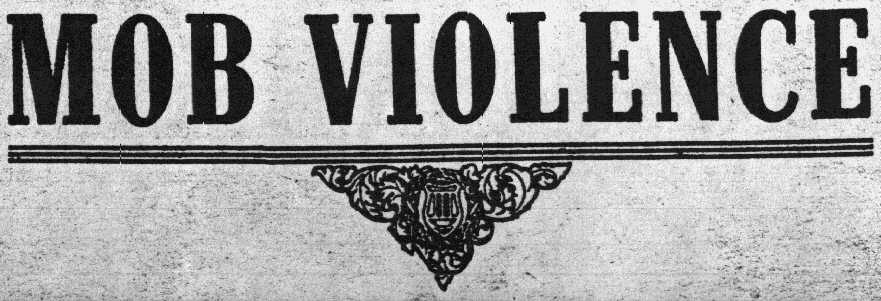
It was a Monday evening, June 12, 1920, when two young adults from West
Duluth went to see the J.A.Robinson's circus. The circus followed the
rails from town to town and state to state. After the night show had been
given, the big tents were taken down, the paraphernalia incident to circus life packed and the trains loaded for the trip to the range. The West Duluth girl and her escort alleged that while watching the loading of the trains they were surrounded by a number of negroes, one of whom place a gun against the head of the escort at the same time pinning his arms behind his back, while several others carried the girl to a neighboring clump of bushes and there criminally assaulted her. (Its should be mentioned that after the alleged incident the young man escorted the girl home, at which time they did not inform her parents of the attack. Instead the young man went to work spotting ore boats on the docks, its here that he told his father of the incident. His father contacted the parents of the girl and the incident was reported to the police.)
With the matter reported to the police, the circus train, which was just about to pull out, was held up, every negro in the outfit lined up and an inspection made. Then followed the arrest of several of the group who were pointed out by the young couple as having taken part in the fearful atrocity.
The afternoon additions of the news papers informed Duluth residents of the assault and arrests. As the story went the rounds the following day, throats began to echo the word "vengeance".
It was reported that in West Duluth, "Hell was poppin'". Towards evening, large numbers of men began to gather in the western section of the city and finally to parade up and down the streets. At 7:00 p.m., a truck marked "City Truck" affixed with a long rope began driving through the streets. Men filling the truck, called out as they went, "Come on! Join the neck-tie party!"
The mob slowly grew, more trucks found their place in line, as they progressed from West Duluth towards the city jail. When the mob arrives at the jail it orders the police to hand over the prisoners. After being turned away, a young man jumps onto the hood of a truck and incites the crowed, calling for alittle action.
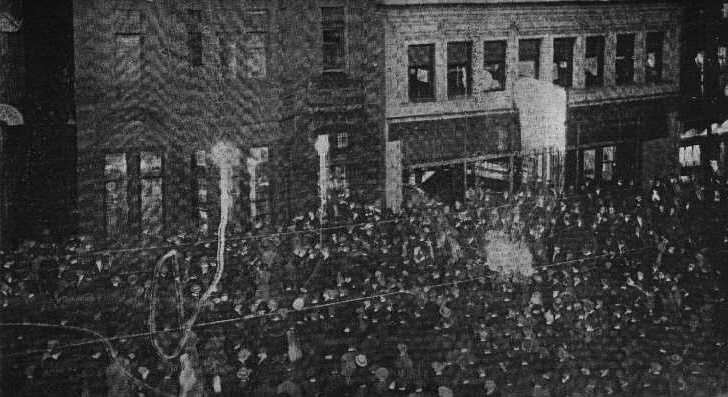
The storming of the city jail.
The police barricade the doors, and are told not to draw their weapons or
fire on the crowd. The Fire department tries to disperse the mob with water hoses, but the hoses are taken over by the mob and used against the police. After seeing their success, the mob now starts a bombardment on the front of the building. Every window was broken and the front door torn down.
Answering a an S.O.S. call from the police, a force of the sheriff's deputies soon arrived on the scene. Their efforts to stay the mob were only momentary and they were soon pushed aside while the crowd pushed on into the station. A demand was made for the prisoners, a search for the cell keys, which had been hidden only a moment before by Jailer Louis Johnson, proving fruitless.
Not waiting for further adieu, the mob began rushing the cell door with heavy timbers. Appeals by Lieut. E.H. Barber, who, in the absence of Chief of Police Murphy, was in charge of the station, and by Hugh M'Clearn, Duluth attorney, failed to check the onslaught. The grill door of the cell room didn't offer much resistance to the blows of the railroad iron ram and the beams brought by the mob. Upon finding a cell which held one negro, the leaders tore the door down, while a rush was started for the boys' department on the second floor, where it was reported the rest of the prisoners were being held.
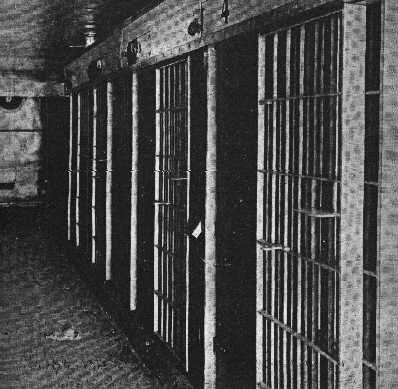
The cells in which the negroes were placed and the mock trial held.
Upon reaching the room, and attack, similar to the one made open the door below, was made. The work did not progress fast enough to suit the leaders however, and a hole three feet square was made in the 16 inch thick wall. Five more negroes were pulled from their cell through the hole and rushed down to the first cell where a mock trial was conducted, three of the negroes being "convicted." The unlucky three were then ushered out into the crowd.
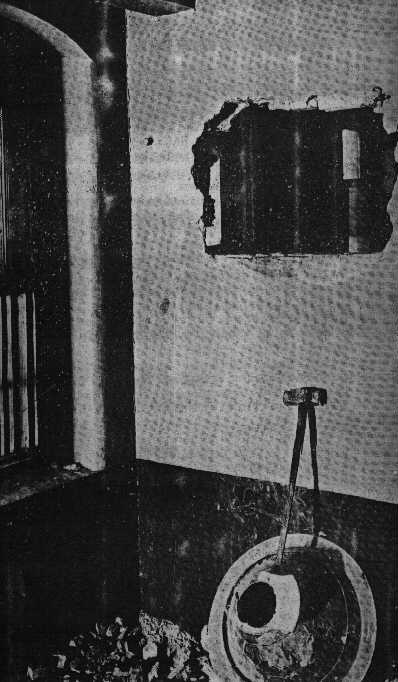
One of the "entrances" by which the mob entered the boys' department cell room, where five of the negroes were being held. Battering of the door did not bring results quick enough--so a hole 3 feet in diameter was made in the wall.
Even as the unfortunate negroes were started for the door, Lieut. Barber, water soaked, continued his pleas, but in vain. His last words to the mob were: "These men should receive their punishment from the law. You are going to be sorry for tonight's work."
A hurried march was then made by the mob up Second avenue to First street. The negroes were badly beaten on the way, while the cry of "kill 'em" rose from the throats of the mob. Climbing up the light pole in front of the Shrine auditorium, several youths arranged the ropes amid cheers of the crowd.
As they were preparing a noose to slip over the head of the first negro, Isaac McGhie, Father W.J. Powers of the Catholic church climbed part way up the pole and began pleading for the safety of the negroes.
"You don't know whether these men are guilty or not," yelled Father Powers. "I know the crime is a most heinous one, but let the law take its course. In the name of God and the church I represent, I ask you to stop."
Cries of "To hell with the law," and "Lynch him," was the response of the mob and the leaders went on with their work.
The first victim, Isaac McGhie, was dropped and nearly kicked and stomped to death before a new rope was strung up and the lynching completed. The body was lifted but a few feet from the ground and the mob shouted "String him up so we can see."
Elmer Jackson, the second victim, met his death calmly. As the rope was being placed around his neck, he pulled a pair of dice from his pocket and threw them to the pavement with the remark:
"I won't need these any more in this world."
A moment later Jackson was lifted into the air and as he went into his dying convulsions, the crowd began to cheer. The rope was then hurriedly put in place for the final victim, Elias Clayton, who had been a witness to the hanging of Jackson. He began weeping and begging for his life and, seeing the hesitancy on the part of the leaders, the mob took up the cry, "Lynch the third one!"
The knot was then tied around Clayton's neck and he was rapidly drawn up the pole, high above the heads of the throng. As he was dying, a white man high up on the pole began to kick at his head and face to the cheers of the mob.
Following the hanging of the last man, the crowd stood silent for a few minutes gazing at the bodies on the pole. Seeming to be satisfied with their orgies, the mob began to dwindle, although scores of the morbidly inclined lingered about the scene, cutting off pieces of the ropes and the shirts as souvenirs.
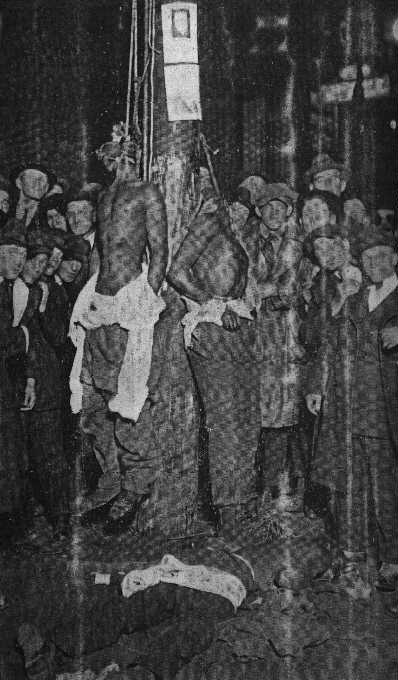
This picture was taken just after the hanging of Eli Clayton, the last of the three negroes to die. His body is shown lying on the street in the foreground. The bodies still hanging from the electric light standard are those of Isaac McGhie and Elmer Jackson. Notice the smirks that the mob wears, satisfied with their job.
During the investigation of the case, the Doctor that examined the young girl found no traces of the assault. The girl herself, saying that she was unconscious at the time, didn't remember the assault, but was sure it took place.
One of the fourteen black men held for the crime was eventually convicted for the crime that in all likelyhood never took place. He was conviced on the bases that the girl had contracted goneria, and he admitted to have had it three years prier. He was sentenced to 30 years in Stillwater State
Prison. Only three of the 19 mob leaders charged were convicted. The
three, convicted of inciting a mob, were sentenced to less than five years.
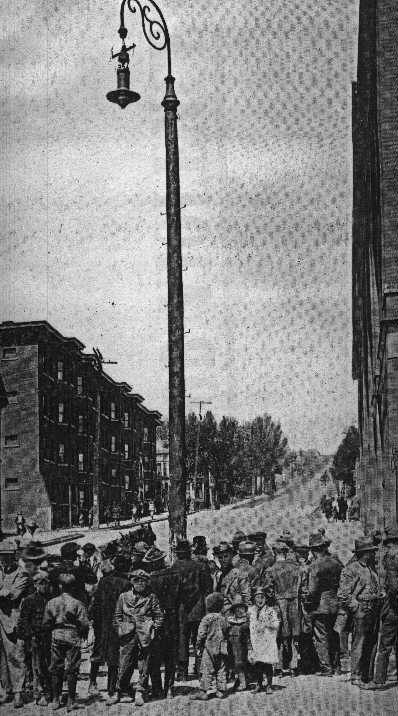
The lamp post which was used as the gallows. People flocked to the corner, Second Avenue East and First Street, the following day.
The sources for this summery are:
MOB VIOLENCE, 1920, Duluth Publishing Co., Duluth, Minn. (A photographic review sold for 35 cents.)
The Duluth Herald, 1920
Duluth
News Tribune, 1920
'They Was Just Niggers', Michael W. Fedo (reprinted under the title 'Mob Violence')
All the sources were supplied by Northeast
Minnesota Historical Center
Other places to look!
"Mob Violence
Has No Place"
Springfield
Race Riot
"Lynch Law in
Georgia"






